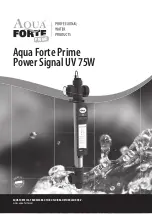
11
17. Re-install bearing retainer (70) onto bearing housing (9) with cap screws (75). Tighten capscrews
with torque
wrench
per assembly drawing torque values.
18. Install dowel pin (37) in front cover (1).
19. Install O-ring (90) in face of front cover (1).
20. Install square housing (4) on shaft (6) and slide it up until it engages dowel pin (37) and counterbore in front cover
(1) and is tight up against front cover face (1).
21. Install key (13) chamfer side up in keyway of shaft (6) inside square housing (4).
NOTE:
If key (13) has a step, install key (13) with step facing up and toward square housing (4).
CAUTION
ATTENTION
When key (13) is installed and pushed up toward drive end, there must be an
approximately .020" gap between it and face of square housing (4). If not, it should be
removed and a small step filed in portion of key (13) that sticks above shaft (6) keyway.
This will prevent key (13) from touching face of square housing (4).
22.
Install pinion gear (11) on shaft (6). Pinion gear (11) should slide freely on shaft (6) and key (13). If not, ensure
key (13) is properly installed and shaft (6) and pinion (11) keyway are free of burrs. Ensure pinion (11) is installed
in stage from which it was removed and is facing direction from which it was removed.
CAUTION
ATTENTION
If gears are installed in wrong housing, pump may not perform properly or may seize
during operation. This is because gears are matched to each housing individually and may
not have correct clearances if installed in another housing. If gears are installed facing
wrong direction, pump may not perform properly or may seize during operation. This is
because some gears have chamfers on only one side. These chamfers must be positioned
facing inside of housing so that there will be no interference with housing radii.
23. Install ring gear (12) in square gear housing (4). Ensure ring gear (12) is installed in stage from which it was
removed and is facing direction from which it was removed.
CAUTION
ATTENTION
If gears are installed in wrong housing, pump may not perform properly or may seize
during operation. This is because gears are matched to each housing individually and may
not have correct clearances if installed in another housing. If gears are installed facing wrong
direction, pump may not perform properly or may seize during operation. This is because
some gears have chamfers on only one side. These chamfers must be positioned facing
inside of housing so that there will be no interference with housing radii.
24. Install O-ring (41) on square gear housing (4).
25. Install dowel pin (37) in square gear housing (4).
26. Install intermediate flange (5) onto shaft (6) and slide it on until it engages pin (37) in face of previously
installed housing (3 or 4) and is tight up against face of previously installed housing (3 or 4).
27. Install capscrews (39) and tighten
with torque wrench
to torque values on assembly drawing. Torque one-half
value for all capscrews first, then torque to full specified torque value. Capscrew tightening pattern should be
across opposite corners for both half torque and full torque tightening.
NOTE:
With capscrews (39) torqued to full value, pump shaft must turn freely by hand and without
significant internal snagging. Otherwise, unit has not been properly assembled.
28. Install key (21), chamfer side up, into keyway of shaft (6).



































